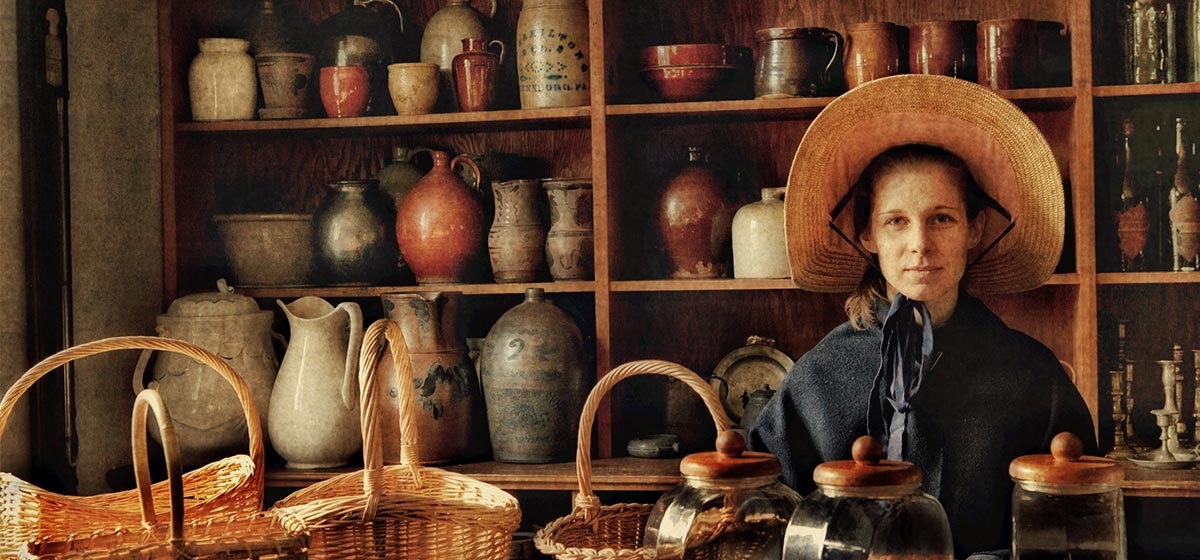Christmas in Utopia

It’s early morning on Christmas Eve in the town of Economy, Pennsylvania. The year is 1828. Twenty-seven-year-old Catharina Langenbacher awakens to the five o’clock gong of the grandfather clock in the sitting room downstairs. By the time she clambers down the crude staircase, her widowed mother is preparing breakfast. Catharina’s 35-year-old brother, Romelius, is milking the family cow in the whitewashed clapboard shed behind the house. Romelius heads the household which includes another widow and her children. Although the two families are not related by blood, they share their domicile and meals as brothers and sisters. To make the most of The Harmony Society’s communal living quarters, many other members live in similar fabricated families.
Born in Wurttemberg, Germany in 1800, Catharina came to America with her family when she was 4 years old. Part of a large group of German emigrés, Catharina’s parents had followed their spiritual leader, George Rapp, in search of refuge from the religious persecution of the state-sanctioned Lutheran Church. In 1805, the year after their arrival, Catharina’s parents signed the Harmony Society’s founding articles, agreeing to pool their material resources and live communistically in the new town of Harmony, Pennsylvania on the outskirts of Zelienople. Since then, the Langenbachers have twice followed the Society to build new towns on the American frontier—one called New Harmony, on the Wabash River in Indiana, and this one—Economy—Ambridge, Pennsylvania.
The town of Economy is self-sufficient. Vegetables come from the dooryard garden; meat, staples and beverages from the Society’s 3,000 acres of farmland, orchards and vineyards. The bricks for their house were made at the Society brickyard. Their clothes woven from fleeces of the Society’s flock of Merino sheep; cotton from the cotton mill; hats from the hatter; socks from the stocking maker; shoes from the shoemaker; crocks from the potter. They grow and manufacture enough for their needs and sell the considerable surplus around the world. What little they can’t grow themselves, like the raw cotton for the Society’s massive cotton mill, or the coffee they drink at breakfast, they import from around the world. Household goods are distributed through the general store which Romelius manages and where Catharina serves as counter clerk.
As the sun rises behind Harmony Ridge, morning’s first rays of light glint off the Ohio River, just steps away from the Langenbachers’ doorstep. Chances are the air was mild that morning as Catharina and Romelius walked the short distance to the store. Although the Commonwealth weather service would not be inaugurated for another seven years, a contemporaneous weather chronicle shows the Three Rivers open to steamboat traffic through Jan. 19, 1829. But later that winter, severe cold iced over the Ohio. The Langenbachers and their fellow Harmonists, however, would work in warmth. In a remarkably prescient use of the advanced technology of the day—steam power—they piped residual heat from the steam engine they used to power their cotton and wool mills to warm the town’s shops and factories.
The Harmonists’ exploitation of steam power exemplifies their pragmatic approach to a singularly spiritual mission—perfecting their inner spirits for the Millennium, the biblically prophesied time when Christ would return to earth to walk among his chosen faithful for a thousand years before the Final Judgment. Harmony Society founder and leader George Rapp had predicted the date of the Millennium nine months hence—Sept. 15, 1829.
In the minds of the Harmonists, this Christmas would be their last before walking with their Savior.
The making of a prophet
Starting more than 50 years prior, in his home village of Iptingen, Germany, George Rapp had delivered stirring sermons advocating less ceremonial pomp and greater religious piety. As word of Rapp’s fervor spread, his new sect increased. As it did, the official state church took anxious notice. When Rapp and his followers refused to conform to the tenets of conventional Lutheranism, Church authorities retaliated with religious persecution, civil fines and, in some cases, imprisonment. Rapp himself spent time imprisoned in the Iptingen church tower.
In response, in 1803 Rapp and three followers embarked to America seeking a place where he and his congregation might flourish. He came upon a tract of 6,912 acres near present-day Zelienople, Pennsylvania.
The following year, 557 of Rapp’s estimated 12,000 German adherents made the trans-Atlantic voyage to build a Utopia in the American wilderness. Catharina and her family were among them.
A practical approach to spiritual perfection
Naturally inclined to self improvement and unswervingly confident that Christ would return upon the appointed day, Rapp drew upon an eclectic mix of scriptural, technical, intellectual and practical resources to prepare for the Millennium—from biblical prophecy, to advanced technology, to works of classical antiquity, to medieval mysticism, to the practice of alchemy.
His plan for salvation centered on a pair of biblical notions as they applied to his prediction of the Millennium: First, that the Harmony Society was the fulfillment of a prophesied Sunwoman from the Book of Revelation, who wandered in the wilderness awaiting the return of Christ, just as the Harmonists were doing in America. And second, that before God created Eve, Adam existed in a Godlike procreative state which obviated the need for sexual intercourse—a practice that would make the Harmonists more worthy of walking with their Lord when He returned to earth.
In 1807, two years after the Society’s founding, Rapp instituted a policy whereby new marriages would no longer be allowed and married couples would renounce their roles as conjugal mates, living celibately as brother and sister.
Although the Harmonists bore few children thereafter, those born prior to the celibacy mandate, along with some adopted outsiders and a few domestic surprises, were educated at the Society school where they were taught the three Rs, as well as music.
True to Rapp’s respect for intelligence and lifelong thirst for knowledge, he acquired a well-stocked library for the use of both students and adults. He established a natural history museum in the Society Feast Hall, complete with a collection of prints, paintings, replicas, taxidermies and specimens of plants, flowers, mammals, birds, fish, shells and minerals.
Rapp went as far in his classical and mystical endeavors as to build a shrine to the Greek goddess of Harmony in the 2½- acre garden behind his house; a medieval maze to induce meditative states of mind; and a rustic stone grotto with a classical Grecian interior designed to contrast visitors’ uncultivated natural states with their refined inner selves.
Yuletide serenity
According to the general store accounts ledger, probably penned by Catharina’s hand, business on Christmas Eve, 1828 looks like any other day of the year. Catharina waits on customers, both Society members and outsiders. Engelhardt Autherieth, supervisor of the Society’s numerous stonemasons, picks up 10 pounds of rice; Maria Neff, wife of Jacob, gets 14 pounds of sugar; and stocking weaver, Georg Schaal, 10 pounds of coffee. As Society members, the goods they receive require no payment but serve as compensation for the work they do without pay.
For nonmembers, such as hired hands and townsfolk, goods are purchased with money. For instance, on that same Christmas Eve, Charles Baker buys a pound of coffee and a yard of muslin for 34 cents. Brod Daniel puts $5.20 worth of sundries on his account, which he settles later. And Wm G. Berring purchases 2,355 shingles for $2.72.
Tomorrow is Christmas. Catharina will go to work as will every other member of the Society. Harmonists didn’t spurn the celebration of the Nativity, but in the days before Santa Claus and Christmas lights, the birth of Christ was marked more by religious zeal than holiday glitter.
According to a Harmonist song titled “Decorate the Festival with Wintergreen,” the day would have been heralded with laurel, myrtle, orange branches, and ivy draped across mantels and lintels, fence gates and sills. Each household had its own evergreen tree trimmed with candles, cookies, popcorn, and nuts wrapped in fancy paper. At noontime, the Society’s children as well those from neighboring farms received a sack filled with candy, colored popcorn, an orange, English walnuts, dried grapes, figs, and dates.
Society members stopped work to gather in the Community Feast Hall for a sumptuous meal of ricesoup, roast veal and beef, apple schnitzel, sauerkraut, white bread, ginger cakes and wine. Talk was not allowed during the feast. Except for the shuffling of feet and the clinking of forks against plates, music played and sung between courses by the Society’s orchestra and choir would be the only sounds the congregants would hear while indulging their palates.
The modest festivities fortified the effects of morning, noon and evening church services officiated by Father Rapp preaching from a seated position at the front of the austere church. Between services, feasting, music and song, Catharina and the other workers would return to their jobs. While clerking at the store that Christmas Day, Catharina entered in the accounts ledger John Riddle’s purchase of coffee, tea, sugar, tobacco, flour and whiskey.
From prophet to tyrant
As idyllic as life among the Harmonists may appear today, contention dogged the Society almost from the start. At the heart of many of the Harmonists’ travails was George Rapp’s domineering personality which from time to time provoked withdrawals from the Society, lawsuits, sex scandals, a mass secession, a state investigation and an open rebellion.
Easily the most gruesome of Harmonist misadventures was the death of George Rapp’s natural-born son, John, who is officially reported as having died in an 1809 mill accident, but is popularly alleged to have succumbed to the ravages of being castrated by his father for siring a child in contravention of the Society’s rule against sexual intercourse between spouses. In a gesture of paternal indulgence which evolved into a massive insult to his authority, the elder Rapp had granted the couple a dispensation from the prohibition against new marriages with the understanding that they would live as celibates, and had officiated at the wedding that gave rise to the unwelcome birth. After John’s death, Rapp subsequently took a talented young man named Frederick Reichert as his adopted son and business manager.
In another regrettable episode, a charlatan religious leader who called himself the Count de Leon caught Rapp’s attention long enough to lure away one-third of the Society’s members. When a dispute over a severance settlement evolved into a riot, the Pennsylvania militia was called out to restore order which, happily, it did without bloodshed.
But perhaps the exploit that most diminished George Rapp’s standing in the eyes of his adherents was a late-life infatuation with a ravishingly beautiful young woman named Hildegarde Mutchler, who served as Rapp’s assistant in his alchemy laboratory.
In addition to employing Hildegarde as supervisor over three laboratory workers, Rapp also called upon her to serve as the requisite virgin in experiments to find the fabled and fictive elixir of spiritual perfection known as the Philosopher’s Stone. When word of Rapp’s dalliances with Hildegarde reached his adopted son, Frederick, the younger man vituperated that he, not Hildegarde, should be Rapp’s virgin and accused his father of violating the Harmonist policy of celibacy.
Whether or not George Rapp’s relationship with Hildegarde ever became intimate, the perception of a 70-year-old prophet of the Millennium and advocate of celibacy being smitten by an ingénue, at the very least made George Rapp look like a doting old fool in the eyes of his followers.
Economic success
As we know today, George Rapp’s predicted date of Christ’s return came and went without incident.
Despite having failed at his spiritual mission, George Rapp had initiated, perhaps unwittingly, one of the grandest social experiments and astounding economic successes in U.S. history. Having come to America in 1804, all but penniless, Rapp by 1844 had stashed away more than half a million dollars in gold and silver in the Society’s vault. The Harmony Society’s efforts to attain spiritual salvation had transformed it into an economic powerhouse rivaling the treasuries of cities, states and nations.
In 1824, when America’s average per capita wealth was $200, the Harmonists’ was $2,000. In 1816, the Society loaned the new state of Indiana $5,000. In 1826, Pittsburgh’s mayor, John Snowden solicited, Rapp’s adopted son, Frederick, for a loan of $20,000 to fund a water system for the city. During the Panic of 1837, the vault in George Rapp’s house is reputed to have contained more gold and silver than the United States Treasury. In 1853, the president of the Ohio and Pennsylvania Railroad arranged to borrow $200,000 from the society. Such was the Harmonists’ economic prowess that they founded their own bank—the Economy Savings Institution.
Following George Rapp’s death in 1847, at the age of 89, administration of the Harmony Society was turned over to a pair of trustees and a board of elders. Catharina’s brother, who had anglicized his name to R.L. (Romelius Langenbacher) Baker, served as one of the trustees. The other was Jacob Henrici, who had succeeded Rapp’s adopted son Frederick as business manager upon his death in 1834.
Final irony
Despite the Harmonists’ extraordinary economic success over almost a century, the seeds of their demise had been planted in their early attempt to achieve spiritual perfection by eschewing conjugal relations between spouses. As they grew older, the childless Harmonists were forced to rely on hired help to work their land and run their businesses. By the time Catharina Langenbacher died in 1874, fewer than 40 Harmonists remained—none with blood heirs. In the 1890s, as the last Harmonists were preparing to die, one of the Society’s adopted children, a dissembling musician named John Duss, became the Society’s principal trustee. By then, the Society had investments in railroads, oil wells, coal, timber, and banking operations as well as ownership of a dozen manufacturing companies, many of which were losing money.
Purportedly concerned for the Society’s financial stability, Duss conducted the first formal audit of the Society’s financial condition, to find many of its business ventures in dire financial straits. Duss embarked upon a campaign of divestiture and restructuring which he claimed saved the Society from financial ruin. Once financial matters were put straight, Duss embarked upon a campaign to fleece the Society of its remaining wealth. He resigned his commission as trustee and installed his wife in his stead. He then assembled an orchestra and toured the United States on the Society’s tab.
In 1905, exactly 100 years after its founding, the last two living Harmonists, one of whom was John Duss’ wife, Susie, decided to close the Society. The move precipitated a decade-long court battle. In 1916, the Dusses were awarded all of the Harmony Society’s remaining assets except for the two-block core of the Society’s buildings and $15,000, which went to the Commonwealth of Pennsylvania, enabling the establishment of Old Economy Village, the Pennsylvania Historical and Museum Commission’s first historic site.
Today, Old Economy Village is open to the public five days a week in testament to a grand social experiment in 19th century America. At Christmas time, visitors enjoy Christmas at the Village—a weekend not unlike Catharina’s Christmas Eve and Day in 1828. The cotton and wool mills are gone, but the Langenbacher residence and the general store still stand amidst the rest of the preserved brick buildings and whitewashed clapboard sheds. The shrine to Harmony and the Stone Grotto adorn the Rapp House Garden which is now tended by volunteers. A seven-foot grandfather clock stands in the sitting room beneath Catharina’s bedroom. And the general store is just a few steps away.
If you close your eyes while standing at the counter, it’s easy to imagine Catharina in her bonnet and apron reaching for a bolt of cloth or scooping a measure of pepper from an earthenware crock while chatting with customers against the whirring of mills in the distance and the clucking of hens in the yards and the lowing of cows in the pastures.
Two centuries later it still feels like Utopia on the Ohio.





